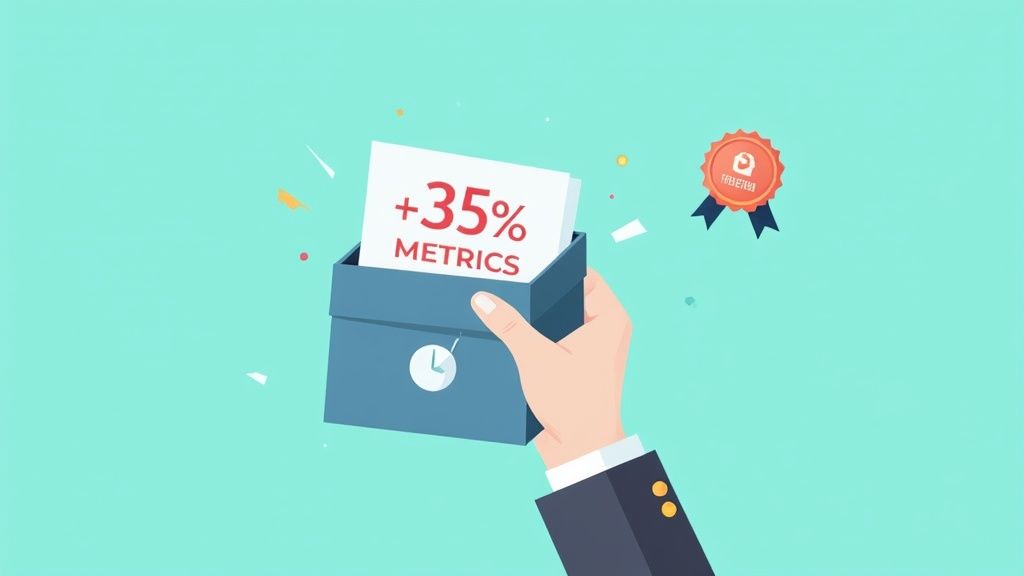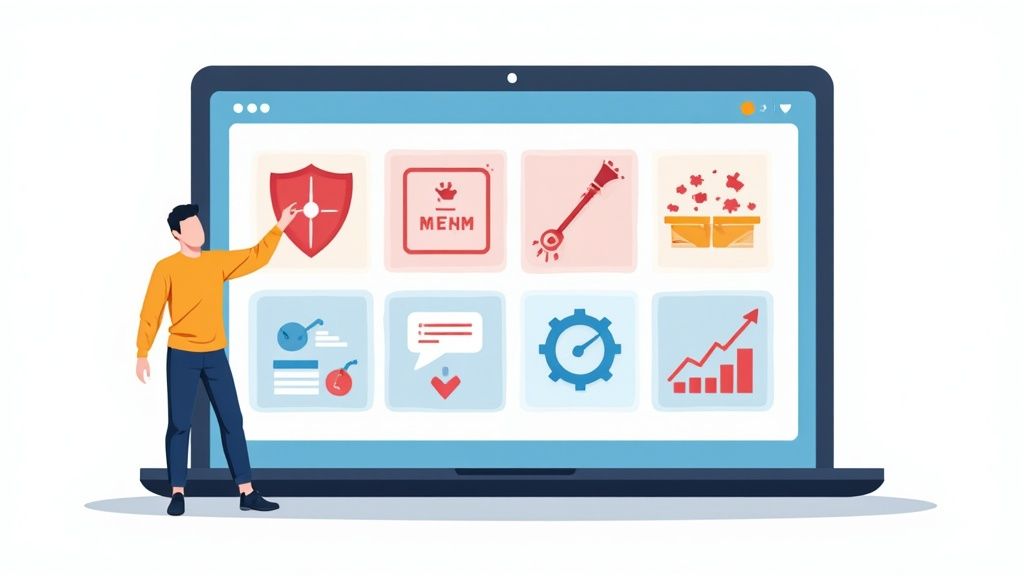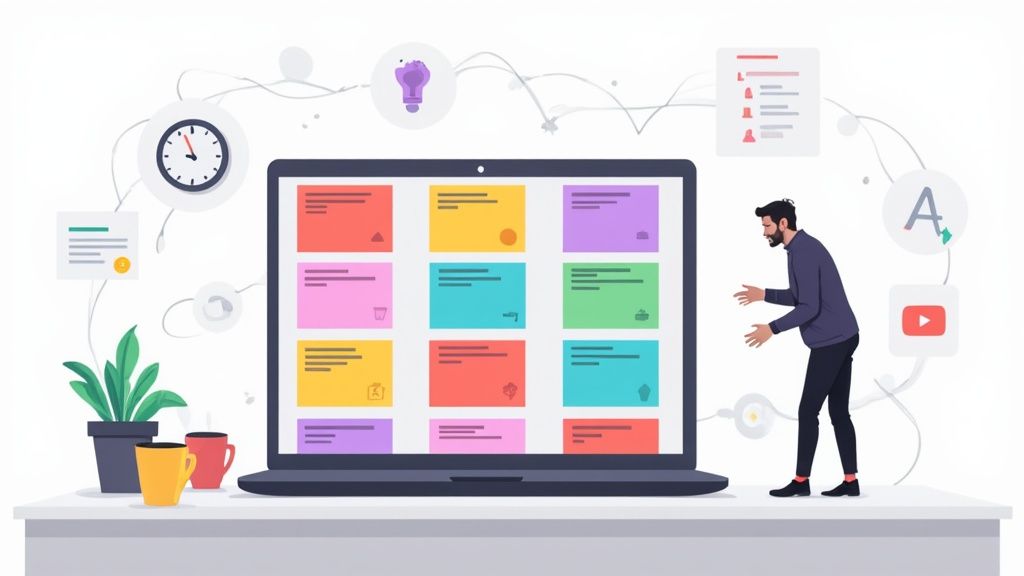7 Proven B2B Cold Email Templates That Convert in 2025

Cold email feels like a numbers game, but it’s really a strategy game. For solo founders and small teams, every send counts. You don't have the budget for massive, low-quality campaigns. You need emails that cut through the noise, build trust, and actually get a reply. Guesswork leads to an empty inbox and wasted time, while a proven framework turns outreach into a reliable source of revenue.
This is your playbook. We are breaking down seven powerful b2b cold email templates designed for specific outcomes, from booking demos to securing partnerships. This isn’t just a list of examples; it's a comprehensive guide to execution. For each template, you'll get a detailed strategic breakdown, the ideal target persona, and a quick-start checklist tailored for one-person teams. We’ll show you not only what to write but also why it works and how to deploy it effectively.
We will cover the entire process, from identifying high-value prospects to launching your campaigns. While many tools can manage outreach, platforms like Apollo are an excellent option for finding verified client contact details and sending personalized sequences at scale. The goal here is to equip you with replicable strategies that transform your cold email efforts from a guessing game into a predictable client acquisition machine. Let’s get started.
1. The Problem-Agitation-Solution (PAS) Cold Email Template
The Problem-Agitation-Solution (PAS) framework is one of the most effective and time-tested B2B cold email templates because it taps directly into the core of persuasive communication: empathy. Instead of leading with your product or service, you start by demonstrating a deep understanding of the prospect's world and its inherent challenges. This model, championed by sales experts like Steli Efti and John Barrows, is designed to build rapport and create urgency by following a simple, powerful, three-step psychological sequence.
This template excels for SaaS and software companies because it logically connects a tangible operational pain point to the clear benefit of a technological solution. It’s a direct path from a problem the prospect is actively experiencing to the relief your product can provide.
Strategic Breakdown
- Problem: Start by identifying a specific, high-stakes problem relevant to your prospect's role and industry. This requires research. Generic problems get ignored; specific, well-researched problems get read.
- Agitation: This is the crucial step. Don't just state the problem; pour salt in the wound. Use data, metrics, or relatable scenarios to highlight the negative consequences of inaction. What happens if this problem isn't solved? Think lost revenue, wasted hours, or missed opportunities.
- Solution: Briefly introduce your product or service as the clear and simple solution to their agitated problem. The goal isn't to detail every feature but to present a bridge from their pain to a better outcome. End with a clear, low-friction call-to-action (CTA).
Pro-Tip: The agitation phase is where most emails fail. To make it powerful, use emotional language and quantify the impact. Phrases like "drains engineering resources" or "leads to a 15% drop in lead quality" are far more effective than "is inefficient."
Quick-Deploy Playbook
This template is ideal when you've identified a common, recurring pain point across a specific market segment, like targeting IT Directors with database management challenges or Marketing Managers struggling with lead attribution.
Target Persona: Marketing Manager at a mid-sized SaaS company.
Use-Case: Introduce a marketing analytics tool that simplifies campaign ROI tracking.
Subject Lines to Test:
- Question about [Prospect's Company Name]'s marketing ROI
- Tired of messy campaign data?
- A simpler way to track [Specific Metric, e.g., MQLs]
Template Example:
Subject: A thought on [Prospect's Company Name]'s campaign tracking
Hi [First Name],
I noticed on your LinkedIn that you're managing multiple marketing channels for [Prospect's Company Name].
Many marketing managers I speak with find it incredibly time-consuming to manually stitch together data from Google Analytics, your CRM, and ad platforms just to prove campaign ROI. This often leads to delayed reports and makes it nearly impossible to quickly decide where to allocate the next month's budget.
Our platform automates this by integrating all your marketing data into one clear dashboard, showing you exactly what’s working in minutes, not hours.
Would you be open to a brief 15-minute call next week to see if we can help you get a clearer picture of your marketing efforts?
Best,
[Your Name]
You can easily find contact details and deploy sequences like this using tools like Apollo, which helps streamline both prospecting and outreach. The key is to customize the "Problem" and "Agitation" sections based on your research for maximum impact.
2. The Value-First/Social Proof Cold Email Template
The Value-First/Social Proof template flips the traditional sales script on its head. Instead of asking for something, you give something first. This B2B cold email template is built on the principle of reciprocity; by providing immediate, tangible value or demonstrating undeniable success with a similar company, you earn the right to your prospect's attention. Popularized by sales leaders at HubSpot and Outreach, this approach is designed to disarm skepticism by leading with proof, not a pitch.

This template is exceptionally effective for B2B service businesses like consulting firms, marketing agencies, and financial services. It works because it replaces vague promises with concrete results, instantly building credibility and making your outreach feel less like a sales pitch and more like a valuable, expert insight.
Strategic Breakdown
- Value-First Hook: Start with a specific, data-backed insight or a piece of value directly relevant to the prospect. This could be a compelling statistic, an observation about their business, or a relevant case study result.
- Social Proof: Connect that value to your work by citing specific, metric-driven results you've achieved for a similar company. Naming a recognizable competitor or a company in their industry is a powerful way to establish relevance.
- Light Touch Solution: Briefly link the proven result to your service. The goal isn't a hard sell but to position your company as the vehicle for achieving similar success.
- Low-Friction CTA: The call-to-action should be a small, easy next step, like a brief call to share more insights or discuss the strategy behind your results.
Pro-Tip: The more specific your social proof, the better. "We helped a B2B SaaS company increase MQLs by 40% in Q2" is far more compelling than "We help companies get more leads." Quantify everything.
Quick-Deploy Playbook
Use this template when you have strong case studies and clear, metric-based results within a specific industry niche. It’s perfect for targeting decision-makers who are measured on performance metrics, such as VPs of Sales or Heads of Growth.
Target Persona: VP of Sales at an enterprise software company.
Use-Case: Introduce an outbound sales consulting service.
Subject Lines to Test:
- Idea for [Prospect's Company Name]'s sales cadence
- [Competitor Name] saw a 25% lift
- Your team's outbound strategy
Template Example:
Subject: A thought on [Prospect's Company Name]'s outbound
Hi [First Name],
I saw that you're scaling the sales team at [Prospect's Company Name] and thought this might be relevant.
We recently helped [Competitor or Similar Company Name] overhaul their outbound sequence, which resulted in a 25% increase in qualified meetings booked and shortened their average sales cycle by 12 days. The key was a hyper-personalized, multi-channel approach focused on their highest-value accounts.
Our team specializes in implementing these exact frameworks for enterprise software companies.
Would you be open to a 15-minute call next week? I'd be happy to walk you through the framework we used and see if it could be valuable for your team.
Best,
[Your Name]
Service-based businesses can use this strategy to great effect. To learn more about this approach, see the email playbook for B2B service businesses. Using a tool like Apollo allows you to find verified contact information for your target personas and send these highly-customized sequences at scale.
3. The Mutual Connection/Warm Introduction Cold Email Template
This is arguably the most powerful of all B2B cold email templates because it bypasses the "cold" element almost entirely. By leveraging a shared relationship, you transform a stranger's inbox into a familiar, trusted space. This template, a favorite among top-tier sales professionals and executive recruiters, relies on social proof and credibility transfer to immediately capture a prospect's attention. Instead of proving your own value, you borrow the trust already established by a mutual connection.
The mutual connection email is universally effective across industries but is especially potent for high-value B2B services, executive recruitment, and enterprise sales. It cuts through the noise by making the outreach feel like a personal referral rather than an unsolicited sales pitch, dramatically increasing open and reply rates.
Strategic Breakdown
- The Opener: Lead immediately with the mutual connection's name. Don't bury it. The first sentence should establish the shared relationship, creating an instant pattern interrupt and compelling the prospect to keep reading.
- The Context: Briefly explain how you know the mutual connection and, if possible, why they thought it made sense for you to reach out. This adds a layer of authenticity and shows you’ve done your homework. A vague "we both know John" is weak; "John and I worked together on the Acme project, and he mentioned your team was scaling its engineering efforts" is powerful.
- The Value Proposition: Connect the reason for your outreach directly to a potential benefit for the prospect. Keep this part concise and focused on their potential gain, not your company's history.
- The Ask: Your call-to-action should be simple and respectful of their time. Since you're coming via a referral, a direct ask for a brief meeting is more likely to be accepted.
Pro-Tip: Always get permission from your mutual connection before using their name. A surprise name-drop can backfire and damage your relationship with both the prospect and your connection. For best results, ask your connection to make the introduction directly.
Quick-Deploy Playbook
This template is perfect when targeting senior-level executives or decision-makers who are otherwise difficult to reach. Use LinkedIn Sales Navigator or your own professional network to identify shared connections before launching your outreach.
Target Persona: VP of Engineering at a fast-growing tech startup.
Use-Case: A specialized dev agency looking to offer outsourced talent.
Subject Lines to Test:
- [Mutual Connection's Name] suggested I reach out
- Introduction from [Mutual Connection's Name]
- A question from a friend of [Mutual Connection's Name]
Template Example:
Subject: Introduction from Sarah Jones
Hi [First Name],
Sarah Jones and I were discussing the challenges of scaling engineering teams, and she mentioned the incredible growth you're overseeing at [Prospect's Company Name].
She thought it might be valuable for us to connect. My agency specializes in providing senior-level, vetted remote developers to help tech companies like yours scale efficiently without the long hiring cycles. We helped [Similar Company] double their feature velocity in under six months.
Would you have 15 minutes next Tuesday or Thursday to discuss if this could be a fit for your team's roadmap?
Best,
[Your Name]
Finding mutual connections and validating prospect information is a critical first step. You can use platforms like Apollo to research contacts within your target accounts and identify potential shared relationships before deploying your personalized email sequence. The key is to make the introduction feel as warm and authentic as possible.
4. The Curiosity-Gap/Hook-Driven Cold Email Template
The Curiosity-Gap/Hook-Driven template is a powerful B2B cold email strategy designed to cut through the noise of a crowded inbox. It leverages a psychological principle known as the information gap theory, which states that when people feel a gap between what they know and what they want to know, they are motivated to fill that gap. Popularized by experts like Brian Dean and Justin McGill, this template uses intriguing, sometimes provocative, subject lines and opening hooks to compel a prospect to open and read on.

This template is exceptionally effective for reaching high-level decision-makers and prospects in competitive industries who receive dozens of pitches daily. By breaking their pattern of automatically deleting sales emails, you create an opportunity to present your value proposition to an engaged reader.
Strategic Breakdown
- Hook: Start with a subject line or first sentence that creates a knowledge gap. It should be short, unconventional, and directly relevant to the prospect's world, but withhold a key piece of information.
- Reel-In: Immediately connect the hook to a genuine and relevant observation about the prospect or their business. This step is critical; it proves the hook isn't just clickbait and builds credibility.
- Value Proposition: Once you have their attention, deliver a concise value proposition that resolves the curiosity you created. Explain how your solution addresses the implied problem or opportunity from your hook. End with a clear, direct call-to-action.
Pro-Tip: The biggest risk with this template is creating a "bait-and-switch" feeling. The payoff in the email body must be directly related to the curiosity you generated in the hook. If the hook is "We broke your website," the email must detail a specific, real vulnerability you discovered.
Quick-Deploy Playbook
This approach is perfect for agencies, consultants, and SaaS companies that can identify a specific, observable issue or opportunity for their prospects, such as SEO errors, a missing pixel on a website, or a top-performing competitor's strategy.
Target Persona: Head of Growth at a B2B tech startup.
Use-Case: A content marketing agency offering a strategy to outperform a competitor.
Subject Lines to Test:
- Your competitor [Competitor's Name]
- A thought on your content strategy
- Broken link on your site
Template Example:
Subject: Quick question about [Prospect's Company Name]'s blog
Hi [First Name],
I was looking at your blog post, "[Title of a Recent Blog Post]," and noticed you’re currently ranking #8 for the keyword "[Target Keyword]."
Your competitor, [Competitor's Name], is holding the #1 spot, but our analysis shows their article is missing critical data points on [Specific Sub-Topic A] and [Specific Sub-Topic B]. We believe updating your existing post to include this information could help you capture the top position within a few weeks.
We specialize in content optimization strategies that drive these kinds of results for B2B tech companies.
Would you be open to a brief chat next week to discuss this specific opportunity?
Best,
[Your Name]
You can learn more about how to craft a cold email that doesn't feel like a cold email for your agency at Unkoa.com. To deploy these targeted campaigns at scale, platforms like Apollo are excellent for sourcing verified contact details and automating your outreach sequences.
5. The Industry-Specific/Vertical-Targeted Cold Email Template
Speaking your prospect's language is the fastest way to build trust and credibility. The Industry-Specific B2B cold email template moves beyond generic business benefits and focuses on the unique challenges, regulations, metrics, and terminology of a specific vertical. This approach, heavily used by Vertical SaaS leaders like Veeva (for life sciences) and specialized consulting firms, proves you haven't just found a contact, you've done your homework on their entire ecosystem.
This template is powerful because it immediately signals that you are an industry insider, not just another vendor. It’s the difference between telling a manufacturer you can "improve efficiency" versus telling them you can "reduce scrap rates by 8% and improve OEE," which is far more resonant. By referencing industry-specific pain points, you cut through the noise and position yourself as a specialist.
Strategic Breakdown
- Demonstrate Niche Expertise: Start by referencing a specific industry trend, regulation, or common challenge. Mentioning HIPAA in an email to a healthcare provider or FINRA requirements to a fintech company instantly builds rapport.
- Use Their Language (Lexicon): Incorporate industry-specific acronyms and terminology naturally. This shows you understand their world and aren't just copy-pasting a generic template.
- Provide Vertical-Specific Proof: The solution should be framed with an industry-relevant case study or metric. Instead of a generic ROI, use a stat like "helped a similar e-commerce brand reduce cart abandonment by 15%." The call-to-action should also feel tailored to their context.
Pro-Tip: Your research is your leverage. Spend 15 minutes reading a vertical-specific publication like Healthcare IT News or Manufacturing Today before writing your email. Mentioning a recent article or market shift shows you’re engaged and current.
Quick-Deploy Playbook
This template is most effective when your product or service has a clear, proven application within a specific industry. It’s ideal for targeting roles where compliance, specialized workflows, and industry benchmarks are critical decision-making factors.
Target Persona: Compliance Officer at a mid-sized financial technology (Fintech) firm.
Use-Case: Introduce a compliance automation platform that helps manage SEC regulations.
Subject Lines to Test:
- Question about [Prospect's Company Name]'s SEC reporting
- New FINRA rule & your compliance workflow
- Automating for [specific regulation, e.g., Rule 606]
Template Example:
Subject: A thought on [Prospect's Company Name]'s compliance workflow
Hi [First Name],
Given your role at [Prospect's Company Name], I imagine staying ahead of evolving SEC and FINRA regulations is a constant priority.
Many fintech compliance officers I've spoken to are concerned about the manual effort required to document and audit trade surveillance, which creates risk and drains hours from the team. With the recent focus on data integrity, one small slip-up can lead to costly fines.
Our platform is designed specifically for fintechs to automate compliance monitoring and reporting, reducing audit prep time by up to 60% while ensuring you're always FINRA-compliant.
Would you be open to a 15-minute chat next Tuesday to discuss how we help firms like yours streamline their regulatory obligations?
Best,
[Your Name]
Finding the right compliance officers and their contact details can be done efficiently with prospecting tools. From there, you can launch a highly targeted sequence using a platform like Apollo, ensuring your specialized message reaches the right inbox.
6. The Referral/Authority-Building Cold Email Template
The Referral/Authority-Building template flips the traditional cold email on its head. Instead of immediately pitching, it builds a bridge of familiarity and respect by referencing the prospect's own work, content, or public appearances. This approach, championed by thought leaders like Tim Ferriss and Ramit Sethi, establishes a warm context by positioning you as an engaged member of their audience before you ever ask for their time. It's a strategy rooted in genuine appreciation and intellectual respect.
This B2B cold email template is highly effective for consultants, high-ticket service providers, and anyone selling a solution that requires deep industry expertise. By demonstrating that you’ve done your homework and value the prospect's contributions, you immediately stand out from the 99% of emails that are purely self-serving. It transforms a cold outreach into a peer-level conversation.
Strategic Breakdown
- Reference: Start by citing a specific piece of their work: a podcast episode, a LinkedIn post, a research report, or a talk they gave. Be precise. "Your recent article on Q3 data trends" is better than "I like your content."
- Genuine Insight: Add a brief, thoughtful comment or question about their content. This proves you actually consumed it and aren't just name-dropping. It shows you’re a thinker, not just a seller.
- Bridge to Your Value: Subtly connect their idea to a related concept or challenge you specialize in. The goal is to introduce your expertise as a natural extension of the conversation, not an abrupt sales pitch.
- Low-Friction Ask: End with a very small call-to-action (CTA). Instead of a 30-minute demo, ask for a brief chat to exchange ideas, share a relevant resource, or get their take on a related trend.
Pro-Tip: The key to this template is authenticity. Your insight must be genuine. Before sending, amplify their content on your own social channels (like LinkedIn) and tag them. This "warms up" the outreach and shows your appreciation is public, not just a private sales tactic.
Quick-Deploy Playbook
This template is perfect for reaching influential decision-makers, industry experts, or creators who are inundated with generic pitches. It works best when you have a well-defined niche and can offer a truly valuable perspective.
Target Persona: Head of Innovation at a fintech company who recently published a white paper.
Use-Case: A consultant specializing in AI implementation wants to offer services.
Subject Lines to Test:
- Your white paper on [Topic]
- A question about your [Article/Podcast Title]
- Loved your insights on [Specific Point]
- Quick thought on your [Conference Name] talk
Template Example:
Subject: Your recent white paper on decentralized finance
Hi [First Name],
I just finished reading your team’s white paper on the future of DeFi in enterprise settings, and your section on tokenization models was particularly insightful.
You made a powerful point about the security challenges of bridging legacy systems. It made me think about how we've seen similar hurdles when implementing AI-driven fraud detection in that exact environment. The data integration problem is often the biggest bottleneck.
We recently developed a framework that helps mitigate this specific integration risk. I thought you might find it relevant to your research.
Would you be open to a brief 15-minute call next week to compare notes on this?
Best,
[Your Name]
Finding the right person and their contact information is the first step. You can use platforms like Apollo to identify key decision-makers who are actively publishing content and then manage the outreach sequence. Personalize the "Reference" and "Insight" for each prospect to ensure your email lands with credibility and impact.
7. The Personalized Multi-Step Sequence/Campaign Cold Email Template
In complex B2B sales, a single email is rarely enough to capture attention and drive a decision. The Personalized Multi-Step Sequence is a strategic framework built for persistence and value delivery over time. Instead of putting all your eggs in one basket, this approach uses a coordinated 3-to-7-email campaign where each message builds on the last, offers a new angle, or introduces a different value proposition. This method, championed by modern sales platforms like Outreach.io and SalesLoft, acknowledges that high-value prospects are busy and require multiple, value-driven touchpoints to engage.
This template is essential for enterprise software, high-ticket consulting, or any solution with a long sales cycle and multiple decision-makers. It allows you to educate, build trust, and stay top-of-mind without being repetitive or annoying, making it one of the most effective b2b cold email templates for complex deals.
Strategic Breakdown
- Layered Value: The core principle is that each email must provide new, standalone value. The first email might identify a problem, the second could share a relevant case study, a third might offer a valuable resource (like a whitepaper), and a final one could create urgency.
- Persona-Centric Angles: In enterprise sales, you're often selling to different departments (IT, finance, operations). A sequence allows you to tailor messages to each persona. Email 1 might focus on ROI for a CFO, while Email 2 highlights technical integration for a CTO.
- Scheduled Persistence: The sequence automates the follow-up process, ensuring you are persistent without having to manually track every interaction. The timing is crucial; emails are spaced out (typically 3-5 days apart) to avoid overwhelming the prospect.
- Intelligent Automation: The sequence isn't just a blind series of emails. It should use triggers to automatically pause or stop if a prospect replies, clicks a link, or books a meeting, ensuring you don’t send an automated follow-up to someone who has already engaged.
Pro-Tip: Don't make every follow-up a "just checking in" or "bumping this up" email. This adds zero value. Instead, frame each touchpoint with a new reason for reaching out. A great strategy is to follow a Problem > Social Proof > Resource > CTA sequence.
Quick-Deploy Playbook
This approach is ideal when targeting larger organizations where decisions involve multiple stakeholders and require significant budget approval. It’s perfect for introducing a multifaceted platform or a high-value consulting service.
Target Persona: Head of Operations at a Fortune 500 logistics company.
Use-Case: Introduce an enterprise-level supply chain optimization platform.
Subject Lines to Test (Vary Across Sequence):
- Email 1: Idea for optimizing [Prospect's Company Name]'s supply chain
- Email 2: How [Competitor Name] cut their logistics costs by 15%
- Email 3: A resource for [Prospect's Title]
- Email 4: Quick question
Template Example (Email 1 of a 4-Step Sequence):
Subject: Idea for optimizing [Prospect's Company Name]'s supply chain
Hi [First Name],
Given your role overseeing operations at [Prospect's Company Name], I imagine that reducing freight costs without sacrificing delivery speed is a constant priority.
Logistics leaders in your industry often struggle with fragmented visibility across carriers, which leads to inefficiencies and missed savings opportunities that can cost millions annually.
Our platform provides a unified dashboard to track and optimize every shipment in real-time, helping companies like yours identify cost-saving routes and consolidate shipments more effectively.
Would you be open to a brief 15-minute call next Tuesday to discuss how we might be able to find similar efficiencies for [Prospect's Company Name]?
Best,
[Your Name]
You can effectively manage and automate such campaigns using powerful outreach tools. For more information, you can explore this ultimate guide to automated outreach for B2B sales on unkoa.com. The key is to map out the entire sequence in advance, ensuring each step logically progresses the conversation.
7 B2B Cold Email Templates Compared
| Template | Implementation complexity | Resource requirements | Expected outcomes | Ideal use cases | Key advantages | Key drawbacks |
|---|---|---|---|---|---|---|
| The Problem-Agitation-Solution (PAS) | Medium–High — needs targeted research and strong copywriting | Time for company/prospect research, skilled copywriter, supporting data | Strong engagement and urgency; good for high-ticket B2B (open ~15–25% when personalized) | SaaS & enterprise software targeting decision-makers and complex problems | Fast path from awareness to consideration; creates urgency and shows problem empathy | Research-intensive; can feel manipulative if over‑agitated; less effective for unaware prospects |
| Value-First / Social Proof | Medium — craft insightful lead and embed proof early | Case studies, verifiable metrics, content library, subject-matter experts | Higher-quality replies; builds trust (response ~20–30% for quality prospects) | Consultancies, agencies, professional services selling by expertise | Establishes immediate credibility; positions sender as expert; attracts serious prospects | Requires proven results and content; slower ROI and harder to scale |
| Mutual Connection / Warm Introduction | Low (message simple) but high upstream effort to build/secure intros | Network development, permission from connector, relationship management | Very high response and conversion (authentic intros 40–60%) and faster deal cycles | Recruiters, executive search, partnerships, mid-market B2B | Instant credibility and trust; better-qualified leads; lower friction | Limited scalability; must obtain connector permission; risk to connector’s reputation |
| Curiosity-Gap / Hook-Driven | Low–Medium — craft compelling hooks and strong follow-ups | Creative copywriting, frequent A/B testing, monitoring deliverability | Very high open rates (25–40%); engagement spike but higher churn risk | High-volume outreach to busy execs or crowded inboxes | Breaks through noise; memorable; drives opens and internal sharing | Can appear as clickbait; higher unsubscribe/deliverability risk; may attract unqualified responses |
| Industry-Specific / Vertical-Targeted | High — deep vertical research and tailored messaging | Vertical expertise, industry case studies, regulatory knowledge | High relevance and conversion; shorter sales cycles (response ~30–35% when relevant) | Enterprise software, compliance solutions, industry-specific services | Perceived specialization; easier credibility and qualification | Time- and resource-intensive per vertical; hard to scale; needs continual updates |
| Referral / Authority-Building | Medium–High — requires genuine engagement with prospect content | Time to consume prospect’s work, sender thought leadership assets, content to share | High credibility and likelihood of share/engagement; slower transactional velocity | Outreach to thought leaders, podcast hosts, published authors, executives | Builds peer-to-peer relationships and personal brand; drives organic reach | Time-consuming; hard to scale; requires authentic content and patience |
| Personalized Multi-Step Sequence / Campaign | High — sequence design, automation, and tracking required | Email automation (Outreach/SalesLoft/HubSpot), CRM hygiene, multiple content pieces | Higher conversion across long cycles (enterprise conversion ~25–40%); improved scoring | Complex B2B sales with long decision cycles and multiple stakeholders | Multiple angles increase resonance; progressive disclosure; data-driven optimization | Requires planning, automation, tracking; risk of fatigue/unsubscribes and operational overhead |
Do This Next: Your 30-Minute Cold Email Quickstart
You've just navigated a comprehensive playbook of powerful b2b cold email templates, from the directness of the PAS framework to the strategic patience of a multi-step sequence. We’ve dissected subject lines, analyzed personalization tokens, and laid out the strategic cadence for each approach. But knowledge without action is just potential. It’s time to turn these concepts into your next client.
The core lesson from every template in this guide is simple: relevance is the new currency of outreach. Generic, mass-blasted emails are dead. The winning strategy is sending the right message to the right person at the right time. This requires a small upfront investment in research and personalization, but the ROI in terms of positive replies, booked meetings, and closed deals is exponential. Whether you're using a Value-First template to showcase a powerful case study or a Curiosity-Gap hook to pique interest, your success hinges on demonstrating that you understand your prospect's world before you ask for their time.
From Template to Traction: Your Action Plan
Feeling overwhelmed by the options? Don't be. The goal isn't to master all seven templates at once. It's to pick one, execute it well, and build momentum. As a solo founder or small team, focused action is your superpower. Here is a step-by-step workflow you can execute in the next 30 minutes to get your campaign off the ground.
- Choose Your Weapon (2 mins): Scroll back through the article and select just one template that resonates most with your offer and target audience. For most service providers, consultants, and agencies, the Value-First / Social Proof Template is a fantastic, high-impact starting point. It's direct, credible, and immediately demonstrates your ability to deliver results.
- Build a Hyper-Targeted "Micro-List" (15 mins): The quality of your prospect list is more important than its size. Log in to a tool like Apollo and build a list of just 20 ideal prospects. Filter aggressively by industry, company size, recent funding, job title, or technologies used. These are your "dream clients," not just random contacts. Verify their email addresses to ensure deliverability.
- Craft Your Master Copy (10 mins): Open a fresh document. Write your email based on the template you chose. Identify your single most compelling case study, metric, or social proof point. Weave this into your subject line and the opening sentence. Populate the body with personalization tokens like , , and a custom field for your research.
- Launch and Learn (3 mins): Import your micro-list and your master copy into your preferred outreach tool, whether it's Apollo, Lemlist, or another platform. Schedule it to send. The most important step is hitting "go." Your first campaign is a data-gathering mission. It will not be perfect, but launching it is infinitely more valuable than endlessly perfecting it.
Your Path Forward
Mastering the art of the cold email is a transformative skill for any B2B professional. It’s the ability to create opportunities out of thin air, to build relationships with key decision-makers, and to control your own pipeline without relying on inbound luck. The b2b cold email templates in this guide are your launchpad. They provide the structure and strategy, but your unique value proposition and genuine personalization are the fuel.
Don't wait for the perfect moment. Take the next 30 minutes, follow the quickstart plan, and send something. The data you gather, the replies you get, and the lessons you learn will be the foundation for your next, even more successful campaign. Start now.





